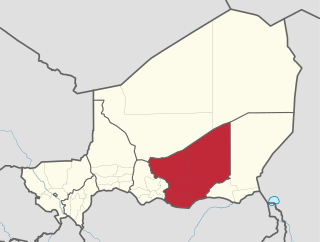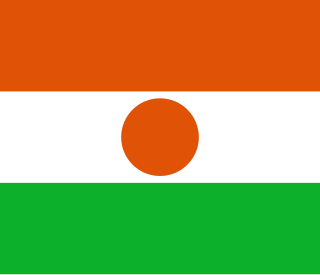
Niger's transport system was little developed during the colonial period (1899–1960), mainly relying upon animal, human, and limited river transport in the far southwest and southeast. No railways were constructed in the colonial period, and roads outside the capital remained unpaved. The Niger River is unsuitable for large-scale river transport, as it lacks depth for most of the year and is broken by rapids in many areas. Camel caravan transport was historically important in the Sahara desert and Sahel regions, which cover most of northern Niger. It is also used in the Sahel where the capital city Niamey is.

The regions of Niger are subdivided into 63 departments. Before the devolution program on 1999–2005, these departments were styled arrondissements. Confusingly, the next level up (regions) had, before 2002-2005 been styled departments. Prior to a revision in 2011, there had been 36 departments. A draft law in August 2011 would expand that number to 63. Until 2010, arrondissements remained a proposed subdivision of departments, though none were used. The decentralisation process, begun in the 1995-1999 period replaced appointed Prefects at Departmental or Arrondissement level with elected councils, first elected in 1999. These were the first local elections held in the history of Niger. Officials elected at commune level are then selected as representatives at Departmental, regional, and National level councils and administration. The Ministry of Decentralisation was created to oversee this task, and to create a national consultative council of local officials.
Birni-N'Konni is a town in the Tahoua Region of Niger, lying immediately north of the border of Nigeria and west of seasonal Maggia River. It is an important market town and transport hub and as of the 2012 census had a population of 63,169. The town is the historic centre of the small pre-colonial Hausa state of Konni. The name comes from the Hausa for "Walled Town of Konni", and many Hausa towns designate the old citadel neighbourhood the "Birni".

Maradi is the second largest city in Niger and the administrative centre of Maradi Region. It is also the seat of the Maradi Department and an Urban Commune.

Zinder Region is one of the seven regions of Niger; the capital of the region is Zinder. The region covers 145,430 km². It is the most populous province of Niger.

Tessaoua, formerly known as Tessawa, is a city located in the Maradi Region of Niger. It has a population of 31,667. Tessaoua is historically an important city in its region. It is situated in a central geographical location. Tessaoua is a midpoint on a historical trade route between Agadez, Niger, in the north and Kano, Nigeria, in the south. During the collapse of the sultanates of Bornu and Sokoto during the late 19th century, the local ruler declared his territory the sultanate of Tessaoua; he signed a treaty of protection with the French captain Cazemajou in 1897, prior to the explorer's murder in nearby Zinder.

Diori Hamani International Airport is an airport in Niamey, the capital of Niger. It is located 9 km (5.6 mi) from Niamey in the south eastern suburbs of the city, along the Route Nationale 1, the major highway linking Niamey with the east of the nation. The airport complex also includes the major base for the Armed Forces of Niger's "Armee d'Air".

The Departments of Niger are subdivided into communes. As of 2005, in the seven Regions and one Capital Area, there were 36 départements, divided into 265 communes, 122 cantons and 81 groupements. The latter two categories cover all areas not covered by Urban Communes or Rural Communes, and are governed by the Department, whereas Communes have elected councils and mayors. Additional semi-autonomous sub-divisions include Sultanates, Provinces and Tribes (tribus). The Nigerien government estimates there are an additional 17000 Villages administered by Rural Communes, while there are over 100 Quartiers administered by Urban Communes.

Abdou Moumouni University, formerly the University of Niamey from 1974 to 1994, is a public university based in Niamey, the capital of Niger. The main campus is situated on the right bank of the Niger River. Historically, its students and faculty have been involved in protest movements in the capital.

The following outline is provided as an overview of and topical guide to Niger:

Niger is divided into eight regions, each of which is named after its capital.

Niger is governed through a four layer, semi-decentralised series of Administrative divisions. Begun 1992, and finally approved with the formation of the Fifth Republic of Niger on 18 July 1999, Niger has been enacting a plan for Decentralisation of some state powers to local bodies. Prior to the 1999-2006 project, Niger's subdivisions were administered via direct appointment from the central government in Niamey. Beginning with Niger's first municipal elections of 2 February 1999, the nation started electing local officials for the first time. Citizens now elect local committee representatives in each Commune, chosen by subdivisions of the commune: "Quarters" in towns and "Villages" in rural areas, with additional groupings for traditional polities and nomadic populations. These officials choose Mayors, and from them are drawn representatives to the Department level. The Departmental council, Prefect, and representatives to the Regional level are chosen here using the same procedure. The system is repeated a Regional level, with a Regional Prefect, council, and representatives to the High Council of Territorial Collectives. The HCCT has only advisory powers, but its members have some financial, planning, educational and environmental powers. The central government oversees this process through the office of the Minister of State for the Interior, Public Safety and Decentralization.
NIGELEC is the Parastatal electric power generation and transmission utility in Niger. It is majority owned by the Government of Niger and was founded in 1968. In 2006 NIGELEC had 178964 subscribers and 300 electrified centers. The NIGELEC management is overseen by the Ministry of Mines and Energy.

The Société Nigérienne de Transports de Voyageurs or SNTV is the Nigerien government owned bus and public transport company.
Air Niger was an airline based in Niamey, Niger.
The 2018 Coupe nationale du Niger is the 43rd edition of the Coupe nationale du Niger, the knockout football competition of Niger.
The 2018–19 Super Ligue is the 49nd season of the Super Ligue, the top-tier football league in Niger. The season started on 28 December 2018.

In 2021, Niger has been affected by subsequent floods due to heavy rains, causing several deaths and widespread damage nationwide. Niamey is the most affected area. At least 62 people died, 60 were injured and 105,690 individuals have been affected by the floods. Most fatalities were reported in Maradi Region with 18 deaths.









